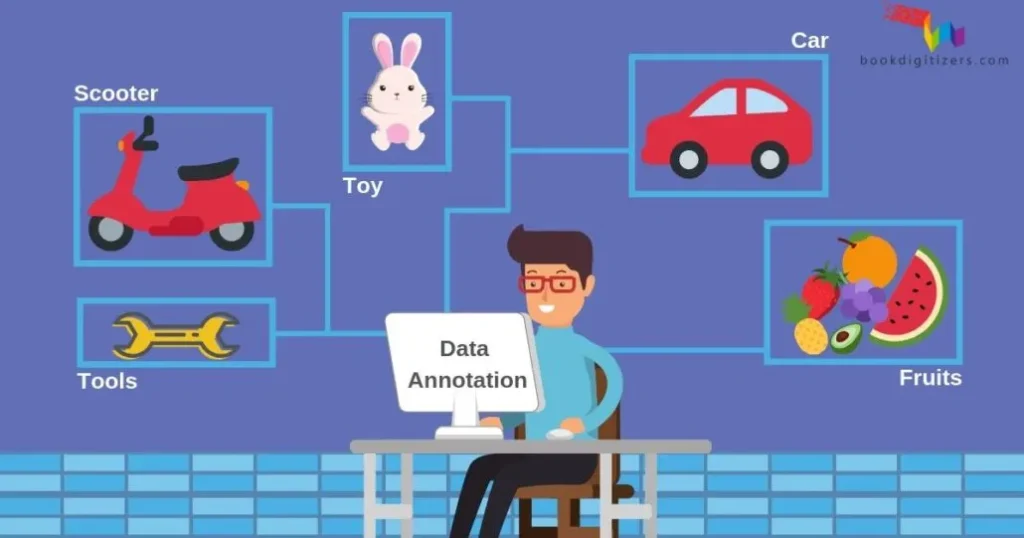
Experts claim that about 80% of time spent on AI projects goes into preparing and labeling data. Coding tends to steal all the attention. But it’s ai annotation that determines how well models handle real-world tasks.
What Does Data Annotation Mean?
Data annotation involves giving raw information some meaning so machines can make sense of it. While humans can spot a cat in a picture without much thought, machines need thousands of examples labeled as “cat” to identify one.
Annotation comes in different types:
- Image tagging means drawing boxes around things like animals, people, or cars.
- Text labeling involves sorting emails for spam or figuring out if a customer review is positive or not.
- Audio annotation focuses on writing down spoken words or identifying various accents.
- Medical labeling highlights areas like tumors in scans to help AI diagnostic tools.
Platforms like ai annotation.tech make this task easier. They blend automated systems with manual checks to improve accuracy.
Why Experts Focus on AI Annotation
AI needs examples to learn. Dr. Andrew Ng, a respected AI researcher, said in 2024, “Better data often beats better algorithms.” This idea is still true in 2025. Even a advanced neural network cannot perform well if it relies on labeled datasets.
Accurate annotation offers many advantages:
- Improved model accuracy – Clean and reliable data leads to better predictions.
- Less bias – Proper labeling avoids uneven outcomes.
- Faster scaling – Datasets that are pre-labeled let businesses speed up model training.
- Compliance and safety – In fields like healthcare, mislabeled data risks serious consequences.
Rushing through or skipping annotation is a huge error that businesses often make. It’s like trying to put up a skyscraper without laying down a strong foundation first.
Can Data Annotation Be a Career?
Yes, it can be. Although data scientists tend to get most of the credit, annotators are the core of many AI teams. Many entry-level positions here don’t ask for coding skills, which makes AI annotation an easy way to step into an AI career.
Here are some roles you could aim for:
- Annotation Specialist – responsible for adding labels to the data.
- Quality Reviewer – Checking and ensuring the work stays accurate and consistent across the board.
- Project Manager – Taking charge of teams of annotators.
- Platform Developer – Creating tools like ai annotation.tech to make the whole process more efficient.
A 2024 LinkedIn Emerging Jobs Report shows that demand for data labeling specialists jumped nearly 20% in the last year. This rise shows that companies prefer creating long-term annotation teams rather than relying on outsourcing.
Problems in Data Labeling and Ways to Fix Them
Although annotation plays a key role, it has hurdles:
- Inconsistency: Annotators may not follow the same rules in the same way.
- Scale: Some AI systems need millions of data points labeled.
- Cost: Skilled annotators are valuable, but expanding teams can get pricey.
- Privacy: Working with sensitive data requires following strict laws like GDPR.
Experts recommend using mixed methods to find effective solutions. A good example is ai annotation.tech, which merges machine-generated pre-labeling with human review. This approach lowers expenses, speeds up workflows, and keeps the results accurate.
Proven Tips from Top Companies
To start or expand an AI project, follow these trusted tips often shared by experts:
- Write clear annotation rules to ensure everyone follows the same standards.
- Provide adequate training for annotators—knowing the bigger picture is as important as being precise.
- Build review systems to catch mistakes early.
- Combine automated tools with human oversight to work faster and smarter.
- Refresh datasets often—outdated data makes AI models less effective .
A 2023 study from MIT on self-driving technology found that refreshing annotation sets every six months brought down model errors by close to 15%. This highlights the need to invest in annotation efforts.
How Beginners and Students Can Get into AI Annotation
To start a career in AI, annotation offers one of the most hands-on entry paths. Students, freelancers, and those looking to change careers can begin by:
- Testing ai annotation.tech to understand how annotation systems work in practice.
- Contributing to open projects on GitHub where labeled data is required.
- Creating a simple portfolio by working on public datasets.
- Getting familiar with machine learning basics—you don’t need to master it, but knowing the context helps you annotate better.
It’s easy to get started, but the potential to grow is significant. Even better, annotation jobs build skills like precision, problem-solving, and ethics in AI—all useful throughout the AI field.
What Lies Ahead for Data Annotation
Will humans always play a role in annotation? Many experts believe the future will combine human effort and automation. Automation keeps getting better, but it still finds it hard to handle subtleties. Tasks like spotting sarcasm diagnosing uncommon medical issues, or getting the meaning behind cultural references still rely on human expertise.
AI platforms such as ai annotation.tech won’t replace annotators but will work alongside them. This teamwork boosts project speed, maintains high standards, and supports consistent job opportunities while pushing AI innovation forward.
If you’re concerned that annotation jobs will disappear, industry experts think otherwise. As AI expands, the need for labeled data will increase.
Final Thoughts
Every AI tool depends on a huge amount of labeled data. Models without proper data annotation end up being either unreliable or even risky. Businesses use it as a key step to create dependable AI, and for people, it opens doors to start an AI-related job without needing advanced technical skills.
Platforms like ai annotation.tech are pushing boundaries while experts emphasize how crucial high-quality data is. Annotation has moved from being a minor detail to becoming the main focus.
If you want to be part of the AI movement, don’t stop at understanding how models function. Learn how to label data, because that’s where all the important work begins.


